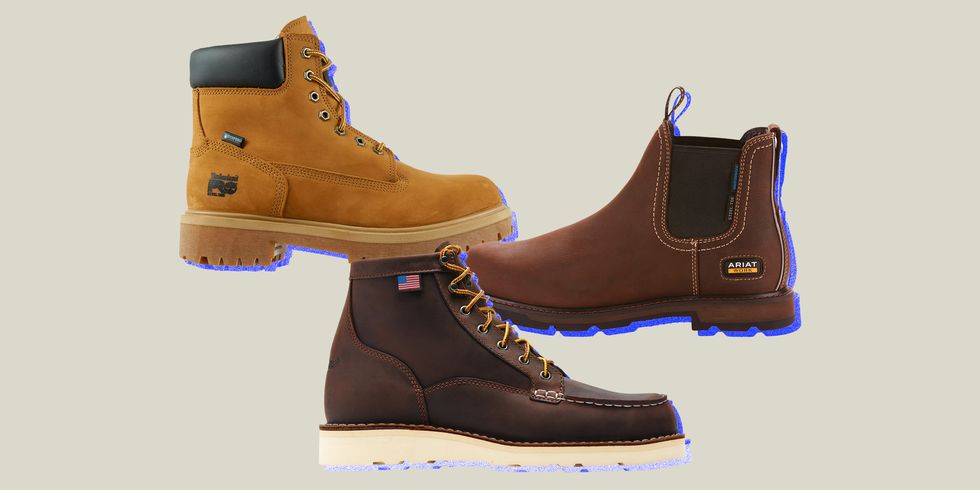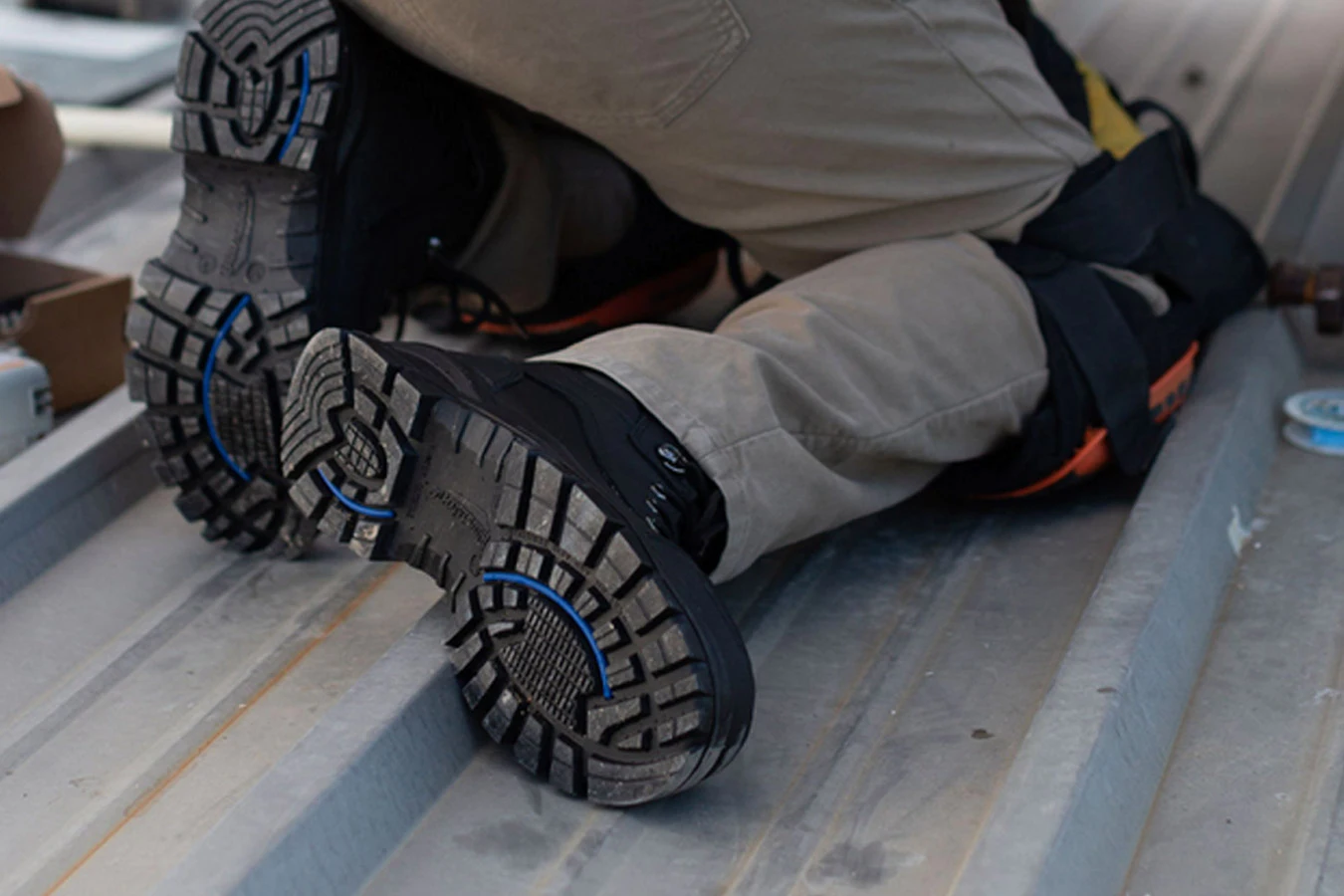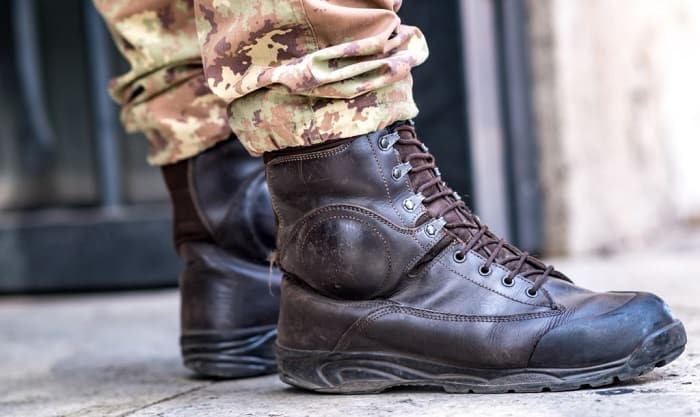Are you a mechanic looking for a reliable pair of work boots to protect your feet on the job? Then you’ve come to the right place!
You’ll find all the information you need to make an informed decision with this comprehensive guide. Whether you’re concerned about safety, comfort, durability or style, you can choose the best work boots for your unique needs.
Work boots are a vital piece of equipment for any mechanic. The right pair of work boots can make a world of difference when it comes to keeping your feet safe and comfortable on the job. In this guide, we will discuss why work boots are important, what features to look for when shopping for the perfect pair, and the best types of boots for mechanics.
We will start with a discussion of the importance of protecting your feet at work in order to safely and effectively perform your tasks. From there, we’ll talk about selecting the best work boot features to fit your needs such as slip-resistance outsoles, steel toes and electric shock protection. We’ll also explore different boot types including waterproof options plus leather or canvas uppers that are better suited for warm weather climates. Finally, we’ll wrap up by providing a brief overview on how to properly care for mechanics’ work boots in order to extend their life span and keep them looking their best.

Factors to consider when choosing work boots for mechanics
There are several important factors to consider when choosing the right pair of work boots for mechanics. Each job requires certain features, so it is important to assess the necessary features before making a purchase. In addition, different manufacturers will have different options available that are designed to fit specific needs.
Firstly, you should consider the material of the boot. Leather is generally considered to be more durable than synthetic materials and can provide more protection for the foot; however, it can also be heavier and less breathable than other materials. For jobs that involve working in wet conditions or require protection from electrical shocks, steel toe caps are an essential feature which many work boots come with. Similarly, any boots intended for use on slippery surfaces should include Slip Sensitive outsoles which provide better traction on the ground and increase safety when walking on hazardous surfaces.
In addition to safety features, it is also important to consider comfort when selecting your pair of work boots for mechanics. The boot should fit in such a way that allows for unrestricted movement in order to reduce strain on the feet and ankles while on the job. Insoles designed specifically for cushioning may help reduce fatigue as well as good arch support which can help counteract any problems related to pronation or supination (foot roll). Finally, waterproof uppers will keep feet dry and prevent water from seeping into the interior of the shoe which could lead to blisters or other forms of discomfort.
Safety features
When selecting work boots for mechanics, safety features are of the utmost importance. Steel toes and steel plates provide the highest level of protection and are needed when working with heavy machinery or materials. Steel toe boots provide a much higher level of protection than traditional work boots, as they shield your feet against impacts or compressions that may occur while on the job. They also protect you from punctures and sharp objects that often accompany manual labor.
If you require enhanced protection but don’t need steel toe protection, composite toe is an option worth considering. Composite toe boots provide the same shape, fit, and feel as steel toe boots with a slight difference in weight.
In addition to offering protection against impacts or compressions, safety work shoes also feature slip-resistant outsoles for skid prevention on slippery surfaces; waterproof membranes to keep feet dry in wet conditions; abrasion-resistant materials providing added durability; ankle straps for extra stability; electrical hazard (EH) ratings; metatarsal guards for additional support on the top part of your foot; contour heels to reduce fatigue when standing for long periods of time; puncture-resistant soles to prevent sharp objects from penetrating through the shoe; and shock absorbent midsoles for cushioning against vibrations and shocks your muscles experience when walking or standing all day long.
The best way to choose appropriate safety features is by evaluating the typical environment in which you’ll be working—and then choosing accordingly based on those conditions and tasks you perform daily. Comparing different styles within each design type can help determine which pair offers the optimal combination of safety and comfort required in order to get through a typical day at work without injury or discomfort.
Comfort and fit

A comfortable, properly fitting work boot is paramount to protecting your feet on the job. Work boots come in many sizes and styles, so choosing the proper fit can be daunting. First and foremost, remember that a work boot should be snug, but not overly tight or constricting. It’s important to buy boots that are designed for your specific type of job — for example, a mechanic shouldn’t wear a tall hunting boot as it won’t protect against the hazards present in an auto shop.
When selecting a pair of work boots make sure they are comfortable inside and out — check the sole and toe box for roominess and ensure you have solid footing. Look for features such as slip-resistant soles, steel toes and waterproofing, keeping in mind that heavier materials may require prolonged break-in periods where comfort is concerned. Overall choose a pair of boots with features to meet the unique requirements of your particular job while at the same time providing maximum comfort.
Materials
When choosing a pair of work boots for mechanics, the material is probably the biggest factor to consider. Certain materials offer better protection against heat, chemicals, punctures and abrasions. That’s why it’s important to pick the right material to protect your feet on the job. There are several different materials used for work boots and each one offers unique benefits depending on your specific needs.
Leather work boots are among the most popular choices for mechanics because of their durability and comfort. Genuine leather is sturdy, water-resistant and able to withstand extreme temperatures without cracking or splitting. These boots also provide abrasion resistance which is essential when working with heavy machinery or in dangerous environments. There are also synthetic leather options that are more affordable but offer less protection than genuine leather boots.
Rubber work boots provide superior protection from liquids, acids and other substances that can damage shoes quickly. They have good traction in wet conditions and can be washed off easily with soap and water after a tough day on the job site. Rubber is also light enough to make it comfortable to wear all day while still offering superior protection from dirt, grime and sharp objects like nails or splinters.
Canvas work boots offer breathability as well as decent levels of support for long jobsites shifts so your feet don’t get overly tired or sore by day’s end. The canvas material molds itself to the shape of your foot better than leather does making them comfortable for all-day wear during long shifts. However, canvas doesn’t typically have as much abrasion resistance compared to leather work boots so they may not last quite as long under harsh conditions.
In addition, some manufacturers produce styles made with waterproof membranes like Gore-Tex® which deliver total protection from rain, snow, sleet, puddles, etc. This type of technology comes at a price but will definitely extend the life of your investment if you need reliability under harsh environmental conditions.
Safety features to look for in work boots for mechanics
When selecting the right work boots for mechanics, safety should be a key consideration. The right pair of protective work boots can provide comfort and protection on the job site, reducing risk of injury while helping you maintain a professional appearance. Workplace hazard assessment and understanding the features each type of boot offers is important when making your choice. Here are some features to pay attention to:
- Steel or Composite Toe: Steel toe caps or composite toe caps offer additional protection from punctures and impact injuries while on the job.
- Waterproofing: If you’ll be operating in wet conditions such as working outdoors in cold climates, waterproof work boots are essential for keeping your feet dry and comfortable. Many brands offer both leather and synthetic uppers with waterproofing technologies for all-day comfort in even the wettest conditions.
- Non-slip sole tread: Working surfaces can get slick, so it’s important to select a boot with a slip-resistant sole for maximum traction on any surface including stairs, slippery pavement and muddy terrain. Oil-resistant special sole design increases durability as well as providing skid resistance and necessary traction to keep you safe on hazardous surfaces .
- Heat resistance: Certain types of materials used in construction such as Kevlar may resist temperatures up to 600 degrees Fahrenheit while still keeping feet comfortable during several hours of continuous wear. Look for heat resistant ratings when researching boots before purchase to ensure that they meet your specific safety requirements on the job site.
Slip-resistant soles
Slip-resistant soles are important features to consider when purchasing a pair of work boots for mechanics. It is preferable that the outsole has a patterned tread and rubberized surface that can grab onto slick surfaces such as tile, concrete, mud and grass. If possible, it’s best to try on boots both on wet and dry surfaces to check for grip.
To ensure all-day comfort, look for dual-density outsoles that combine soft cushioning layered over hard rubber bases, promoting long-lasting protection from any dangers below. Keep an eye out for boots with polyurethane soles as they provide the best dynamic grip when temperatures start to drop during colder months.
Electrical hazard protection
When working with electricity, it’s essential that your feet are well protected. Electrical hazard (EH) footwear is designed to protect you from electrical shocks up to 18,000 volts. EH work boots or shoes typically feature rubber outsoles containing an extra layer of insulation that offers greater protection than those designed for standard occupational hazards.
Many also offer protective toe caps for additional safety when working in hazardous conditions. To ensure your EH boots meet the electrical hazard standard, look for the “EH” symbol on the sole or label of the footwear before purchase.

Puncture-resistant soles
Puncture-resistant soles are one of the most important attributes of shoes for mechanics. The sole of your boot needs to guard against sharp objects like nails, glass and screws. Look for a sole known as “slip-resistant tread” or “oil-resistant outsole” as these materials are designed to protect you from spills, slips and puncture wounds.
Also look for materials such as polyurethane that are lightweight but protective. Most work boots come in steel toe varieties as well, which provide better protection and support than other types of footwear. Be sure to check if your safety requirements require a steel toe boot before purchasing any pair of shoes.
Comfort and fit considerations for work boots for mechanics
When selecting the perfect pair of work boots for mechanics, it is important to consider comfort and fit. Finding the right fit can make all the difference in how comfortable you are while on the job, and your overall productivity. The following tips can help you find a pair of work boots for mechanics that will prove both comfortable and well-fitting:
- Seek suggestions from others. Ask other mechanics what kind of work boots they prefer, as well as any tips or advice they have for finding a pair that fits well.
- Measure your feet. Having an accurate measurement of your feet is essential when shopping for new shoes or boots – regardless of whether or not you’re buying online or in person. Measure your foot from the heel to your longest toe, as well as across its widest part. This information can then be used to compare sizes offered by shoe manufacturers.
- Try them on before purchase. If possible, visit a store to try work boots on yourself before purchasing them online since sizing may differ between manufacturers and styles. Make sure you try on both shoes together in order to ensure a proper fit; if one shoe feels large while the other feels too tight, they probably aren’t sized appropriately for you personally! Not all stores will have every size/style available so ask ahead if possible or shop online with understanding that returns may be necessary if it doesn’t fit perfectly when delivered!
- Choose reputable manufacturers/styles that offer quality materials and adequate support for long hours spent working on your feet. Look into customer reviews that indicate how durable certain styles are; many independent review sites are available online to assist with this research. Be sure to look into footbed cushioning options if you’re standing on hard surfaces all day; some brands offer insoles with extra shock absorption capabilities specifically designed to protect users’ feet during physical labor!
Proper sizing
Finding the right size of work boot for mechanics can be challenging because there are a variety of styles, materials and widths available. The key to finding the perfect fit is to make sure you not only measure your foot properly but also take into account the style of boot you need and the type of activities you will be doing while wearing them.
It’s important to measure your feet accurately when choosing work boots for mechanics in order to get the best fit possible. To do this, you will need a ruler, a piece of paper larger than an 8-1/2” x 11” sheet, a pen or pencil and an empty wall with no baseboard. Remove your socks and stand against a wall with your heel flush against it. Mark the longest area from tip to heal with a pen or pencil at 90 degrees from the wall on your piece of paper. Measure this length (in inches) from your pen or pencil mark and compare that number with our shoe size chart for men’s work boots for mechanics provided below to determine what size you need.
You should also consider width when selecting work boots for mechanics because some manufacturers tend to run narrow or wide depending on their make-up materials. There will usually be one code listed beside each style number indicating if they are M (medium) or W (wide); however, if that information is not listed then it is usually safe to assume it is medium width unless otherwise stated by the manufacturer in their product descriptions online, which can differ by brand*. Lastly, consider any special features such as steel toe protection – many manufacturers require shoe sizes one up from normal when ordering steel-toe versions of specific models due to space needed under normal circumstances for that feature.*
Footwear sizes noted here may vary by style base offered from various manufacturers due to construction materials; therefore sizing discrepancies may exist even within individual brands.* Please use our size chart as an aid in selecting appropriate sizes per manufacturer’s specifications with all associated codes & disclaimers included below on every page where size charts appear in collection groupings* for mention herein above* so conclusion made here represent accurate accurate products comparisons obtainable before orders are finalized*!!
Arch support
Choosing the right arch support for your work boots is important, as it can help keep your feet comfortable and supported throughout the day. To determine which type of arch support is best suited to your needs, think about how you’ll be using your work boots. If you’re constantly on the move, look for thermoplastic polyurethane (TPU) arch support that provides enhanced cushioning and stability.
Another option is a steel toe boot with reinforced arch protection and a slip-resistant outsole. This type of boot offers maximum protection for long days on your feet, providing flexible shock absorption and improved durability in heavy-duty environments. You can also look for boots with extra-thick insoles or memory foam insoles to provide additional cushioning in high impact areas.
At the end of the day, finding a comfortable pair of work boots should always be priority number one. Whether you choose steel toes or reinforced arches, make sure to take the time to evaluate how well each boot supports your arch before making a final decision. By investing in quality pair of work boots with superior arch support, you can help ensure that you stay safe and comfortable throughout the day.

Conclusion
Conclusion: A quality pair of work boots is essential for anyone working in a hands-on mechanical job — from the auto repair shop to the construction site. With the right features, reinforces toecaps and breathable linings, your work boots will keep your feet safe and comfortable while on the job. Whether you are looking for classic steel toe boots or a segmented sole design, there is a wide selection of safety footwear to fit your needs.
In addition to protecting against impact and slips, your work boot should also be an important part of personal care. As part of maintaining good foot health, make sure you pay attention to proper fit when selecting a pair. To get the most out of your work boots, choose ones with features such as excellent cushioning and sweat-wicking technology so that you can focus on the job without worrying about damaging or uncomfortable feet.
By investing in quality work boots designed for tough mechanical jobs, you will have protection from unsafe environments with no sacrifice in comfort. You may also find that using supportive arch inserts or orthotics as you wear them can help prevent long-term injuries associated with overuse or uneven terrain — just make sure that those products are compatible with your chosen pair before purchasing them. With careful selection and proper maintenance, a quality pair of safety shoes can last for years and provide solid protection for wherever life takes you!
FAQ’s
What kind of boots should a mechanic wear?
Mechanics should wear boots that have steel-toes, slip-resistant soles, and provide ample support and protection to the feet.
What do mechanics wear on their feet?
Mechanics typically wear work boots or shoes that are designed to provide safety, comfort, and durability while working on cars or machinery.
How do I protect my feet in work boots?
To protect your feet in work boots, make sure to wear socks that are thick and comfortable, choose boots that fit properly, and look for features like steel-toes and slip-resistant soles.
What do work boots protect you from?
Work boots can protect your feet from a variety of hazards such as falling objects, sharp objects, electrical hazards, and slippery surfaces.
What is a 7 toe boot?
A 7 toe boot is a type of work boot that has an additional piece of leather on the outside of the boot, creating a seventh toe box. This design is intended to provide extra protection to the foot and improve durability.
What should a mechanic wear to work?
Mechanics should wear clothing that is comfortable, durable, and easy to move around in. This may include work pants or coveralls, a work shirt, and work boots.
How do I choose work boots?
When choosing work boots, consider factors such as the type of work you will be doing, the hazards you may encounter, the fit and comfort of the boots, and the durability of the materials.
What boots are good for bad feet?
Boots that have good arch support, shock absorption, and ample cushioning are generally good for people with bad feet. Look for features like orthotic inserts, padded collars, and soft footbeds.
Is it professional to wear boots?
It can be professional to wear boots depending on the industry and work environment. In some industries such as construction or manufacturing, boots are a necessary safety requirement.
What do mechanics wear over their clothes?
Mechanics may wear overalls, coveralls, or a work apron over their clothes to protect their clothing from grease, oil, and other fluids that may be present in the work environment.
See Also :
- Best danner work boots 2023
- Best work boots for mechanics 2023
- Best hvac work boots 2023
- Best insoles for work boots on concrete 2023
- Best work boots for landscaping 2023

